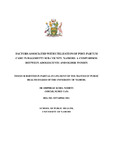| dc.contributor.author | Ndiritu, Shiphrah K | |
| dc.date.accessioned | 2017-01-10T06:19:17Z | |
| dc.date.available | 2017-01-10T06:19:17Z | |
| dc.date.issued | 2011 | |
| dc.identifier.uri | http://hdl.handle.net/11295/100074 | |
| dc.description.abstract | Background: The high maternal mortality and morbidity continues to be an important public health concern internationally. Adolescents face even higher risk compared to older women. Quality postpartum care is a key intervention in reducing the mortality and improving mothers‟ health. Despite this, post-partum care appears to be neglected as evidenced by low utilization.
Objective: This study assessed the factors that are associated with utilization of postpartum care (PPC) among mothers attending maternal and child health clinics and compared the older women and the adolescents.
Methods: The study was done in Dagoretti Sub-county of Nairobi County. The study population was mothers of infants seeking MCH services for themselves or for their infants in the public facilities. This was a descriptive cross-sectional study applying both quantitative and qualitative approaches. Systematic random sampling was done and 420 mothers were interviewed. Five focus group discussions and five key informant interviews were carried out. Data were cleaned, coded and analyzed using SPSS for the quantitative data and N Vivo for the qualitative data. Stratification into adolescents and older women was done during the analysis of the quantitative data.
Results: The level of utilization of post-partum care was found to be low at 32%. The factors that were significantly associated with PPC utilization included health system factors; being given a return date (P =0.000) and having received health information from the health workers (p = 0.05), maternal clinical characteristics; having had a caesarian section (p=0.000) and having had complications at delivery (p =0.001). Having delivered in the facility or attended ANC and the distance to the facility were not significantly associated with seeking PPC, but having attended ANC 4 or more times was. The other factor that was associated with seeking PPC was having a college education. There was no significant difference statistically between adolescents and the older women in the factors that were associated with seeking PPC, p = 0.809. Both the mothers and health workers felt that the health system
Conclusion: The utilization of post-partum care within the study population is low. The health system factors found to be associated with utilization of PPC were being given a return date and having received health information from the health workers. The clinical characteristics that were associated with seeking PPC were having delivered by caesarian section and having had complications at delivery. There was no difference between the adolescents and older women in utilization of PPC.
Recommendations: There is need to enhance the health system factors that are associated positively with seeking PPC. It is important to reach out to the mothers whose clinical characteristics are not associated with seeking PPC to encourage them to seek care. More research needs to be done in the area of the factors associated with seeking PPC and more comparison between the adolescents and the older women done. | en_US |
| dc.language.iso | en | en_US |
| dc.publisher | University of Nairobi | en_US |
| dc.rights | Attribution-NonCommercial-NoDerivs 3.0 United States | * |
| dc.rights.uri | http://creativecommons.org/licenses/by-nc-nd/3.0/us/ | * |
| dc.title | Factors Associated With Utilization of Post-partum Care in Dagoretti Sub-county, Nairobi: a Comparison Between Adolescents and Older Women | en_US |
| dc.type | Thesis | en_US |
| dc.description.department | a
Department of Psychiatry, University of Nairobi, ; bDepartment of Mental Health, School of Medicine,
Moi University, Eldoret, Kenya | |



